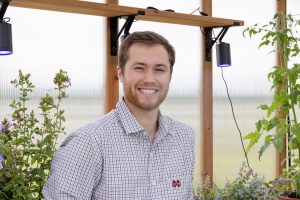Harnessing Light for a Greener Future: A New Era of Sustainable Farming at Mississippi State
November 10, 2025

John Davis
STARKVILLE, Miss.—Nestled within the colorful landscape of North Farm at Mississippi State University, a revolution in agriculture is quietly taking root. The ambitious project led by mechanical engineering graduate student and program manager John Davis promises to rethink how solar energy is harnessed while cultivating plants efficiently. As global food demands rise, the research conducted in the unassuming greenhouse could hold solutions essential for a more sustainable future.
At the heart of Davis' work is Project Power Plant, the intersection of solar energy and plant growth. The project, which began in the fall of 2023, was sparked by the work of previous mechanical engineering students who laid the groundwork for the foundational research. Davis was determined to explore new heights in agricultural technology.
“It all started with the idea of generating solar energy alongside plant cultivation in an efficient way,” he reflected.
Davis explained that while solar energy is praised for its environmental benefits, it has its downsides. A significant downside to their usage is the large amount of space required for the panels to gather energy, space that could be utilized in other ways, such as agriculture. He hopes to alleviate that and allow solar energy and agriculture to work in harmony.
The design utilizes a unique window tint, a film that selectively reflects wavelengths of light not needed for plant growth while allowing crucial visible light to penetrate. This innovative approach not only maximizes the light available for plants, such as tomatoes and basil, but also positions solar panels to optimize electricity generation.
“Both plants and solar panels need light, but neither needs all of it,” Davis explained. “We can filter out the unnecessary wavelengths while making the most out of the sunlight that hits our solar panels.”
By concentrating the right spectrum of light, the project aims to enhance both the yield of fruits and vegetables and the production of clean energy, potentially mitigating the strain on current agricultural systems and energy sources.
The journey hasn’t been without hurdles. Davis recounted the unfortunate destruction of the team’s first greenhouse when a storm swept through the region this past January. Yet, he viewed this setback as a serendipitous opportunity—a chance to build a stronger, more effective system.
“It was a good reset,” he shared, “We took what we learned from that experience and built what we believe is a final, minimally viable product that works.”
This latest iteration of the project has emerged as both robust and capable, as demonstrated by the successful tests conducted over the summer. The positive results indicate that the system can produce competitive electricity while also supporting plant growth, a double win for sustainability.
The social impact of his work should not be understated. As populations grow and urbanization increases, innovative solutions are needed to secure food and energy supplies. The intersection of solar technology and greenhouse agriculture presents a promising avenue for addressing these challenges. By creating infrastructure that provides essential food while generating sustainable energy, researchers like Davis are paving the way for climate-resilient farming practices.
As Davis continues to refine and optimize his project, one thing is clear: this research could hold the key to revolutionizing not just how we grow our food but how we power our lives, fostering a world that respects the delicate balance of our ecosystems while providing for generations to come.
By Camille Carskadon
